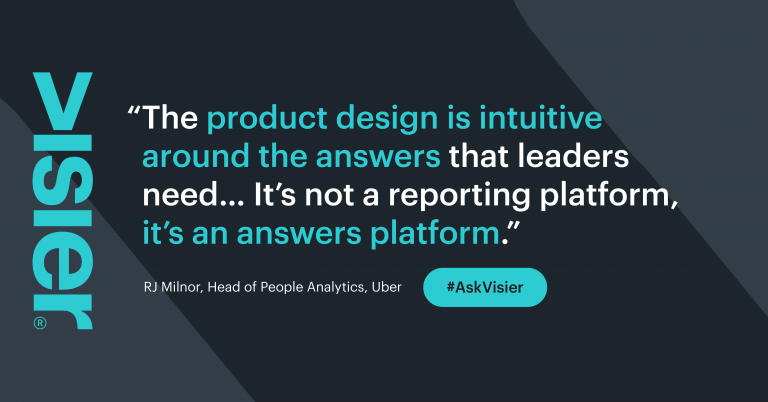How Uber Successfully Enabled Their People Managers with People Analytics
Here’s what the team at Uber did to ensure people managers could easily and securely find the insights they needed to make better talent decisions.

Studies show that data-driven organizations are the top financial performers. The phrase “democratizing your data” is used frequently in conversations around business success driven by strong people analytics. But what does democratizing your data look like in practice?
Democratizing people data means that every people manager–not just HR or the C-Suite–has access to reliable people analytics insights and uses these insights to make decisions. Visier People is built to make data democratization easy and secure, but it might not be the first step in your people analytics adoption process.
It’s important to understand, at the earliest stages, how insights from people analytics will be shared through your business. Knowing this and acting accordingly avoids the trap of starting quickly, but then, needing to rebuild as demand scales.
I recently sat down with RJ Milnor, Head of People Analytics at Uber, for a fireside chat and spent some time discussing the ways Uber delivers people insights to people managers across the company.
“A key early decision was to use Visier as a business tool, not just an internal HR tool,” explained RJ. “ While HR needs to have it, our key stakeholders are the managers and leaders running the business. Visier enables everyone to ask and answer questions themselves using data.”

3 things that made scaling people analytics successful at Uber
According to RJ, here’s what the team at Uber did to ensure people managers could more easily and securely find the insights they needed to make better talent decisions.
1. Make security a top priority
Determine what data will be shared and who will have access to it to avoid security risks. Empowering your workforce to make data-driven decisions doesn’t mean providing easy access to one another’s personal information or making the same level of data visible to every people manager.
Some managers will have different data permissions than others, and protecting sensitive information is a non-negotiable responsibility for HR.
“With Visier, our Analytics team can very carefully curate analyses and use Visier’s security to ensure that only the right people see the right things and that data privacy is rigorously respected,” said RJ.
Giving every people manager only the information they need to make wise decisions while prioritizing data security is critical when rolling out people analytics across the business.

2. Ask leaders what they need
Talk to your people managers about the answers and information that would best help them make data-driven decisions. As RJ explained, “Instead of saying, ‘We’re the people analytics experts’ and taking an expert-driven approach, we took a user-centric approach and said ‘I’m not you. Please tell us what you need and we want to orient around that’, and it was incredibly helpful.”
Instead of asking end users which data points they would like to see, discuss which questions they would like to ask of the data. Broadening the scope of people analytics in this way will encourage people leaders to identify a concern and explore the data story around it—ultimately making course-correct decisions based on what the data reveals.
People leaders who look to data for the truth make higher-quality decisions than those who begin with a “gut feeling” and then look (consciously or unconsciously) for data points to support their hypothesis.

3. Make the data timely and easy to understand
Data democratization isn’t just putting metrics on a dashboard and sending everyone the link. A dashboard filled with disconnected metrics that can’t easily be applied to the problem or opportunity they represent will actually make decision-making even more complex. Avoid this by making the data easy for everyone to interpret and choosing a collection of insights and context that clearly answer a specific question.
Offering real-time insights to people managers is also crucial to helping them make data-driven decisions—and has the bonus effect of increasing people analytics adoption.
One business leader at Uber said, “For a talent decision, I used to have to go to an HR business partner, wait two weeks, and by then, the decision window was gone. Now [with Visier], I can have the current data, interrogate it, then meet with my HR business partner to discuss solutions.”
Democratizing data today means a better future ahead
When people managers are empowered with data and analytics, the organization benefits. According to Mike Zappert, Visier board member and Principal at Adams Street Partners, “The democratization of data is all about pushing the power of data throughout the organization so that the individual managers who are on the front lines—with customers, partners and key stakeholders—can make proactive, data-driven decisions to improve their business.”
To learn more about Uber’s people analytics journey, check out the full Uber customer success story, or our on-demand webinar, Enabling People Analytics at the Speed of Business: A Fireside Chat with Uber Head of People Analytics RJ Milnor.


